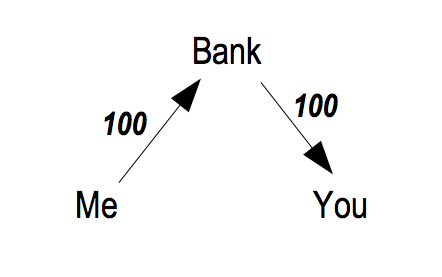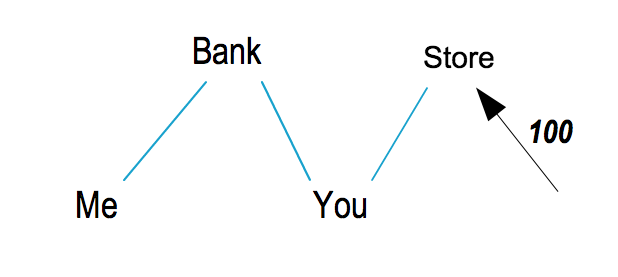Using trust-lines as an anti-sybil mechanism in Swarm Redistribution
In this example from the Ripple whitepaper, where I've given Sally an IOU for $100 in exchange for her IOU, which I pass along to you, and you needed to pay Bob $50, and you discovered that Bob knew and trusted me so I gave Bob $50 of Sally's IOU, which he could give to me in exchange for my IOU, and I could settle $50 of my debt with Sally.
If Erik who Sally trusts then gives Sally an IOU of $50, and You who trust Erik gives him an IOU of $50, then your and Sallys debt clear, and Sally is left with my debt.
There is a cost to Sally trusting me if I do not pay her back, making trust-lines an ideal anti sybil system for Swarm Redistribution.
In EthRipple, written by Ivica Aracic who chose to use the same name I conceptualized a year earlier,
using the ripple function for my transaction to you,
function ripple(address[] chain,
Asset[] assetFlow,
uint amount);
ripple([Me, Sally, You], [USD, USD], 100)
Would also draw a dividend pathway from me to you.
dividendPathway {
address from;
uint amount;
uint timeStamp;
bool isOpen;
}
drawPathways([Me, Sally, You]), [USD, USD], 100)
This draws a pathway between me and Sally, and one between Sally and you. The pathways remain closed until the credit has cleared.
If I do not pay off my debt to Sally, then my pathway will remain closed, while Sally gets a pathway to You.
mapping(address => dividendPathway[]) dividendPathways;
for(uint i = 1; i < chain.length; i++) {
dividendPathways[chain[i]]].push(from: chain[i-1],
amount: amount,
timeStamp: now,
isOpen: false
)};
Debt has to be cleared to close the pathways, further improving trust-lines as an anti-sybil system.
This works with the traditional banking system as well. If I have $100 and send those to you, that creates a pathway between me and the bank, and a pathway between it and you.
Then once my debt to the bank has cleared, that pathway is opened. This rewards me for paying back the bank, as part of the credit clearance.
Swarm Redistribution
The dividend pathways are used to tax IOUs, and redistribute them.
The swarm redistribution iterates through the pathways, and builds up a swarmTree[]. It then redistributes the taxed amount, taxCollected, onto every human in that swarmTree[], who all get a tiny bit of the tax.
When a person makes a transaction of 100 with the Store, then a small amount of tax is sent through the pathways You, Bank and Me.
function iterateThroughSwarm(address _node, uint _timeStamp, uint _taxCollected) {}
That tax is then shared on all the humans in that swarm,
function doSwarm(address _leaf, uint256 _taxCollected) {
uint256 share = _taxCollected / humans.length;
for (uint i = 0; i < humans.length; i++) {
balanceOf[humans[i]] += share;
accounts[humans[i]].assets[EUR].ious[_leaf].amountOwed = share;
totalBasicIncome[humans[i]] += share;
inHumans[humans[i]] = false;
/* Notifiy anyone listening that this swarm took place */
Swarm(_leaf, humans[i], share);
}
delete humans;
}
The pathways are also used up slightly,
if (dividendPathways[_node][i].amount - _taxCollected > 0) {
dividendPathways[_node][i].amount -= _taxCollected;
}
else removePathway(_node, i);
Dividend pathways could be seen as the glue which holds an IOU network together, adding trust and acting as a social cohesion.




It is trivial to create fake debts and pay them.
I have looked at these models in the past and always found them come up short.
How would you also get fake value for those fake debts? For example, in swarm redistribution, the dividends you get in the form of basic income are only useful is they come from an account that has liquidity in the trust network, since you get a tiny tiny IOU from the account that was taxed.
Fake accounts would leech dividends from humans who, in some way over lines of separation, have chosen to trust the scammer. Would the fake accounts distinguish themselves if you look the the credit clearance?
My fake account 1, My fake account 2 and My fake account 3 has trust lines only to Me, would it be easy for You to read that they are fake accounts, based on how they use their dividends, and how the credit clearing would be centralized around Me?
Me and my fake accounts are leeching dividends from You who has let Me into the trust network of Merchant
@dan your comment inspired the idea to do "symmetric" swarm redistribution, the original idea from 2012 was that each person gave to many, with a symmetric design (from 2017), each person only interacts with people they trust and have credit lines to/from
https://steemit.com/res-currency/@johan-nygren/resilience-mutual-currency-with-swarm-redistribution-on-a-person-to-person-ledger
@dan also, Steemit led to this work last year, potential solid evidence that Australopithecus speciated on Danakil (Lumiere, 1981)
https://www.docdroid.net/ml9yKZT/on-the-origin-of-the-species-danakil-as-the-galapagos-of-pliocene-east-africa-2.pdf
Hum, this one is a bit over my head, but was interesting to read for that matter as I am immersing myself into the topic slowly but surely. Maybe I'll be up to par i three years. Thanks for sharing, I'll keep educating myself on the subject and namaste :)
Here is an update, it was inspired by @dan's feedback,
https://telegra.ph/Multi-hop-swarm-redistribution-what-is-the-BIG-idea-04-21